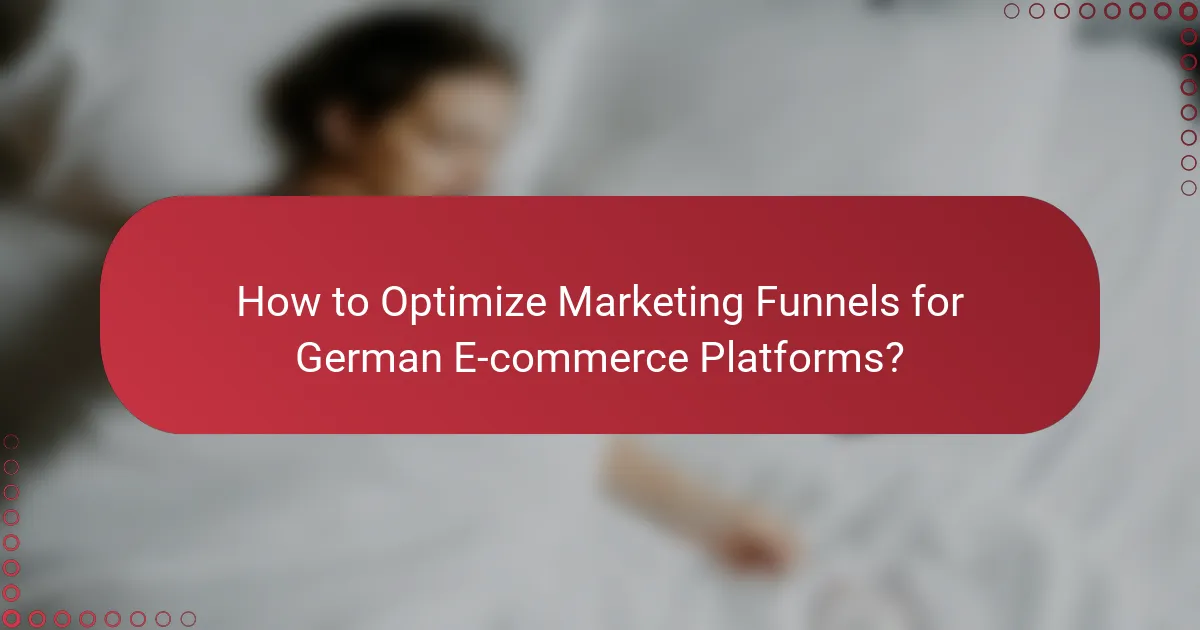Optimizing marketing funnels for German e-commerce platforms is essential for driving conversions and enhancing customer engagement. By focusing on targeted advertising, effective testing, and customer segmentation, businesses can create tailored strategies that guide potential customers through the awareness, consideration, and decision stages. Utilizing data analytics further empowers platforms to identify bottlenecks and refine their marketing approaches, ultimately leading to increased sales.

How to Optimize Marketing Funnels for German E-commerce Platforms?
To optimize marketing funnels for German e-commerce platforms, focus on targeted advertising, effective testing, customer segmentation, and retargeting strategies. These elements help enhance conversion rates and improve overall customer engagement.
Implement targeted display advertising
Targeted display advertising allows you to reach specific audiences based on their online behavior and preferences. In Germany, utilizing platforms like Google Ads or Facebook Ads can help you create tailored campaigns that resonate with local consumers.
Consider using demographic data, interests, and past purchase behavior to refine your audience targeting. This approach can lead to higher click-through rates and improved conversion rates, as ads are more relevant to potential customers.
Utilize A/B testing for conversion rates
A/B testing involves comparing two versions of a webpage or ad to determine which performs better. For German e-commerce platforms, this could mean testing different product descriptions, images, or call-to-action buttons to see which drives more sales.
Run tests over a sufficient period to gather meaningful data, ideally targeting a sample size that reflects your typical traffic. Aim for a clear metric to measure success, such as increased sales or lower bounce rates, to inform your decisions.
Leverage customer segmentation strategies
Customer segmentation involves dividing your audience into distinct groups based on shared characteristics. In the German market, consider factors like age, location, and shopping habits to create targeted marketing messages that resonate with each segment.
Utilizing segmentation can improve personalization, leading to higher engagement and conversion rates. For instance, offering tailored promotions to specific age groups or regions can enhance the relevance of your marketing efforts.
Incorporate retargeting campaigns
Retargeting campaigns focus on re-engaging users who have previously interacted with your website but did not complete a purchase. In Germany, using platforms like Google Display Network can help you serve ads to these users as they browse other sites.
Set up retargeting ads that remind potential customers of the products they viewed, possibly with special offers or discounts. This strategy can significantly increase the likelihood of conversions by keeping your brand top-of-mind for interested shoppers.

What are the key components of a successful marketing funnel?
A successful marketing funnel consists of three main components: awareness, consideration, and decision. Each stage requires tailored tactics and strategies to effectively guide potential customers from initial interest to final purchase.
Awareness stage tactics
In the awareness stage, the goal is to attract potential customers and make them aware of your brand. Effective tactics include content marketing, social media advertising, and search engine optimization (SEO). Utilizing targeted ads on platforms like Facebook or Instagram can help reach specific demographics in Germany.
Consider creating engaging blog posts or videos that address common pain points for your audience. This not only boosts visibility but also establishes your brand as a trusted resource.
Consideration stage strategies
During the consideration stage, potential customers evaluate your offerings against competitors. Providing detailed product information, customer testimonials, and comparison guides can help influence their decision. Email marketing campaigns that offer personalized recommendations based on previous interactions can also be effective.
In Germany, consider leveraging local influencers to review your products, as this can enhance credibility and encourage trust among potential buyers.
Decision stage elements
The decision stage is where potential customers finalize their purchase. Key elements include clear calls-to-action, limited-time offers, and easy checkout processes. Ensure that your website is optimized for mobile users, as many customers in Germany shop via smartphones.
Offering multiple payment options, such as PayPal and credit cards, can also reduce friction during the checkout process, leading to higher conversion rates. Providing a satisfaction guarantee or easy return policy can further reassure customers and encourage them to complete their purchase.

How can data analytics improve funnel optimization?
Data analytics significantly enhances funnel optimization by providing insights into user behavior and conversion rates. By leveraging analytics tools, e-commerce platforms can identify bottlenecks, understand customer preferences, and refine marketing strategies to increase sales.
Track user behavior on platforms
Tracking user behavior is essential for understanding how customers interact with your e-commerce platform. Tools like Google Analytics or specialized software can monitor actions such as page views, clicks, and time spent on each page. This data helps identify which parts of the funnel are performing well and which need improvement.
For instance, if users frequently abandon their carts at the payment stage, it may indicate issues with the payment process or unexpected costs. Addressing these areas can lead to higher conversion rates.
Analyze conversion metrics
Analyzing conversion metrics provides a clear picture of how effectively your funnel turns visitors into customers. Key metrics include conversion rate, average order value, and customer acquisition cost. Regularly reviewing these figures allows you to spot trends and make data-driven decisions.
For example, if the conversion rate drops significantly, it may signal a need to revisit your marketing messages or website design. A/B testing different elements can help determine what resonates best with your audience.
Utilize heatmaps for user engagement
Heatmaps are a powerful tool for visualizing user engagement on your platform. They show where users click, scroll, and spend the most time, helping you understand which areas attract attention and which are ignored. Tools like Hotjar or Crazy Egg can generate these insights.
By analyzing heatmaps, you can optimize page layouts, improve call-to-action placements, and enhance overall user experience. For example, if a significant number of users are clicking on a non-interactive element, it may be worth redesigning that area to improve engagement and conversions.

What role does customer feedback play in funnel optimization?
Customer feedback is crucial for optimizing marketing funnels, as it provides insights into user experiences and preferences. By understanding customer sentiments, e-commerce platforms in Germany can refine their strategies to enhance conversion rates and customer satisfaction.
Identify pain points through surveys
Surveys are an effective tool for identifying pain points in the customer journey. By asking targeted questions, businesses can uncover specific areas where customers face challenges, such as website navigation or checkout processes. Consider using a mix of quantitative and qualitative questions to gather comprehensive feedback.
For best results, keep surveys concise and offer incentives for completion, such as discounts or loyalty points. Aim for a response rate of around 10-20% to ensure the data is representative of your customer base.
Incorporate reviews and testimonials
Reviews and testimonials play a significant role in building trust and credibility. By showcasing positive feedback on product pages and marketing materials, e-commerce platforms can influence potential buyers’ decisions. Highlighting user-generated content can also enhance authenticity.
Encourage customers to leave reviews after purchases and consider implementing a follow-up email strategy. Aim to gather reviews from at least 20-30% of your customers to create a robust collection of testimonials that can effectively support your marketing efforts.

What are the best tools for optimizing marketing funnels in Germany?
To effectively optimize marketing funnels in Germany, businesses should leverage tools that provide comprehensive tracking, user insights, and automation capabilities. Key tools include Google Analytics, Hotjar, and HubSpot, each offering unique features that can enhance the efficiency of marketing strategies.
Google Analytics for tracking
Google Analytics is essential for tracking user behavior throughout the marketing funnel. It allows e-commerce platforms to monitor metrics such as traffic sources, conversion rates, and user engagement, providing valuable insights into customer journeys.
To maximize its effectiveness, set up goals and funnels within the platform to visualize where users drop off. Regularly analyze reports to identify trends and areas needing improvement, focusing on metrics that align with your business objectives.
Hotjar for user insights
Hotjar offers powerful tools for gathering user insights through heatmaps, session recordings, and feedback polls. This information helps identify how users interact with your site, revealing pain points and opportunities for optimization.
Utilize heatmaps to see where users click most frequently and adjust your design accordingly. Session recordings can highlight navigation issues, while feedback polls provide direct user input, helping you make informed decisions to enhance the user experience.
HubSpot for automation
HubSpot is a robust platform for automating marketing processes, making it easier to nurture leads through the funnel. Its features include email marketing automation, lead scoring, and CRM integration, streamlining communication with potential customers.
To effectively use HubSpot, segment your audience based on behavior and demographics, allowing for personalized marketing efforts. Regularly review automation workflows to ensure they align with your goals and adjust them based on performance metrics.



